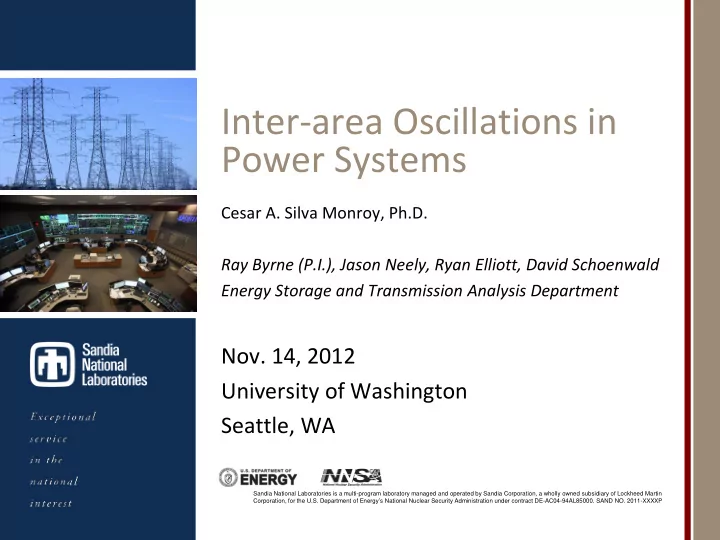

Photos placed in Inter-area Oscillations in horizontal position with even amount of white space Power Systems between photos and header Cesar A. Silva Monroy, Ph.D. Photos placed in horizontal position with even amount of white Ray Byrne (P.I.), Jason Neely, Ryan Elliott, David Schoenwald space between photos and header Energy Storage and Transmission Analysis Department Nov. 14, 2012 University of Washington Seattle, WA Sandia National Laboratories is a multi-program laboratory managed and operated by Sandia Corporation, a wholly owned subsidiary of Lockheed Martin Corporation, for the U.S. Department of Energy’s National Nuclear Security Administration under contract DE-AC04-94AL85000. SAND NO. 2011-XXXXP
Outline Introduction What are Inter-area Oscillations? 6-Bus Example of Inter-area Oscillations Inter-area Oscillations in the WECC Mitigation Strategies Conclusions
Introduction The power system is operated in a conservative way Inter-area oscillations are difficult to detect Inter-area oscillations can cause blackouts (e.g., WECC 1996) Operation of the system closer to its stability limit saves money (e.g., transmission deferral). Loading of transmission paths follow several stability “limits” (e.g., thermal, voltage) Inter-area oscillations limits loading of transmission paths (e.g., COI)
What are Inter-area Oscillations? Oscillations (modes) in power systems can be divided into: Local modes Oscillations associated with electrically “close” groups of generators. Generally observed at frequencies >1 Hz. Sometimes caused by inadequate tuning of control systems (exciters, HVDC converters, SVCs). Inter-area modes Oscillations associated with the flow of power between “electrically far” areas. Generally observed at frequencies between 0.1-1 Hz. Groups of generators in one area swinging against another group of generators in another area. Occur across weak or heavily loaded transmission paths. Local and inter-area modes are small-signal stability issues.
Example of Inter-area Oscillations Small 2-area, 4-generators, 6-bus system Impedance of lines connecting areas 1 and 2 are approximately 10X higher than intra-area lines. PSLF simulation Fault at bus 5 (0.1 sec) Area 1 Area 2
Thermal Generation Area 1 Load: 1,000 MW Gen1: 900 MW (1,200 MVA), Gen2: 400 MW (600 MVA), total: 1,300 MW (1,800 MVA) Area 2 Load: 1,500 MW Gen 3: 582.8 MW (1,050 MVA), Gen 4: 650 MW (1,050 MVA), Total: 1,233 MW (2,100 MVA)
Thermal + Wind Generation Replace Gen 3 (Area 2) with a type 4 wind farm Asynchronous generator connected through power electronics No inertia contribution
Simulation Results - Thermal
Simulation Results – Thermal + Wind
Prony Analysis - Thermal Speed Gen 2 – Gen 4
Prony Analysis – Thermal + Wind Speeds Gen2 – Gen 4
Prony Analysis - Thermal Speed Gen 1 – Gen 4
Prony Analysis – Thermal + Wind Speeds Gen 1 – Gen 4
Inter-area Oscillations in the WECC PSLF models of the WECC for several cases were employed Small signal disturbance: 1.4GW breaker insertion (Chief Joe) at different buses in the system Generator speeds were tracked Mode shape was determine using Prony analysis Damping Frequency Phase North – South Mode (N – S) Alberta – BC Mode (AB – BC) Other modes: BC Mode (0.6Hz) and Montana Mode (0.8Hz)
Light Summer 2012 N – S Mode 0.24 Hz
Light Summer 2022 N – S Mode 0.29 Hz
Heavy Winter 2012 N – S Mode 0.24 Hz
Heavy Winter 2022 N – S Mode 0.24 Hz
2012 Light Summer AB – BC Mode 0.40 Hz
2022 Light Summer AB – BC Mode 0.47 Hz
2012 Heavy Winter AB – BC Mode 0.35 Hz
2022 Heavy Winter AB – BC Mode 0.39 Hz
Mitigation Strategies Control of real power injection into the grid at strategic locations Generators Energy storage HVDC converters Control of real power flow at strategic branches in the grid FACTS Transmission switching Control of reactive power injection into the grid at strategic locations Power electronics based resources (e.g., wind and solar generation) FACTS (e.g., SVCs)
Simulation Results – Thermal + Wind
Thermal + Wind with Droop Ctrl
Thermal + Wind with Droop Ctrl and Synthetic Inertia
Future Work Testing wind controls in the WECC Determine adequate levels of droop control and synthetic inertia (tuning of control schemes) Determine curtailment level or energy storage size that would allow for implementation of controls
Conclusions Results are only as good as the models Test on small system indicate that wind has almost no effect on inter-area oscillations Increases in renewable generation penetration will change mode shapes in the WECC Modes seem to remain well damped, but it could change depending on the location of new renewable plants Active power control, using either curtailed wind plants or in combination with energy storage helps reduce inter-area oscillations
Acknowledgements U.S. Department of Energy, Office of Energy Delivery and Energy Reliability Dr. Imre Gyuk, program manager for energy storage Prof. Dan Trudnowski and Matt Donnelly at Montana Tech University
Want to read more… “Energy Storage Control for Gird Stability” by J. Neely et al. and “Renewable Source Controls for Grid Stability” by R. Byrne et al . SNL reports, to be released Nov. 2012. Power System Oscillations by G. Rogers Power System Stability and Control by P. Kundur
QUESTIONS Cesar A. Silva-Monroy, Ph.D. Research Scientist Energy Storage and Transmission Analysis Sandia National Laboratories http://www.sandia.gov/ess/ E-mail: casilv@sandia.gov
Recommend
More recommend